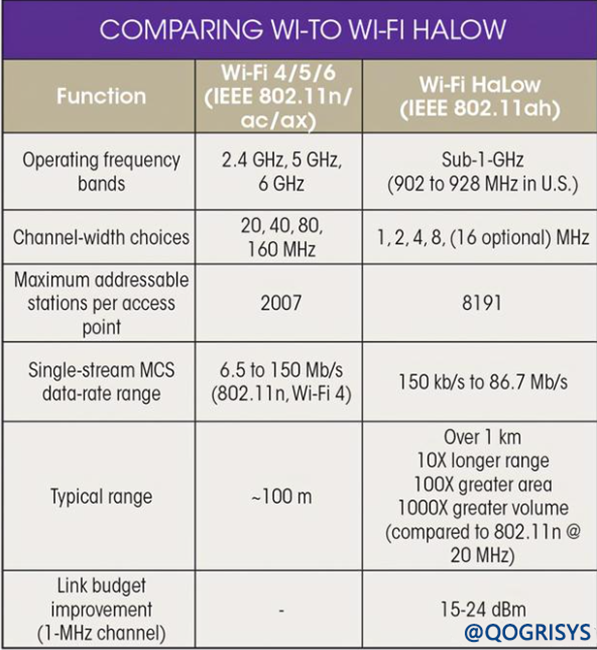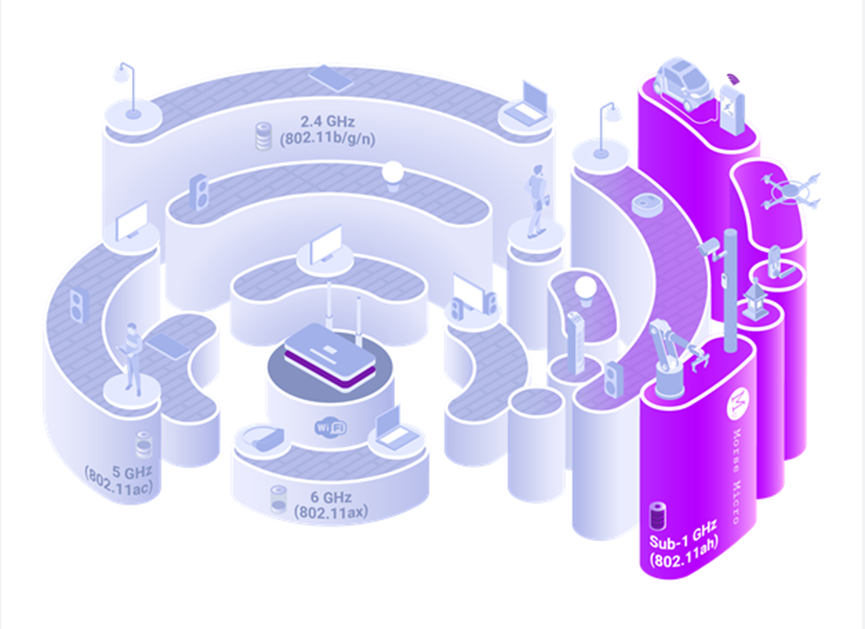Empowering the Internet of Things: The Advantages of WIFI HaLow in Wireless Connectivity
When we talk about wireless network connections, we find that WiFi has become an indispensable part of our daily lives, carrying more than half of the internet traffic and being widely used in various settings such as homes, schools, and entertainment venues. However, despite the ubiquity of protocols like WiFi 4, WiFi 5, and WiFi 6, with the rapid growth of the Internet of Things (IoT), there is a need to reconsider the limitations of traditional WiFi in meeting these emerging requirements.
The emerging business models of IoT place higher demands on remote connectivity and low power consumption. This demand has driven the need for a new type of WiFi protocol known as WiFi HaLow, sometimes pronounced as "HEY-low."
The WiFi HaLow protocol was initially approved by the IEEE 802.11ah working group in 2016 and named WiFi HaLow by the WiFi Alliance. It is a low-power, long-range, and more versatile version of WiFi. By addressing the technical gaps in WiFi, WiFi HaLow is designed to meet the specific needs of IoT devices.

Compared to traditional WiFi, WiFi HaLow has many significant differences:
Highly scalable solution:
A single WIFI HaLow access point can address up to 8191 devices, more than four times the capacity of traditional WiFi access points. In the foreseeable future, WIFI HaLow is capable of connecting every LED bulb, light switch, smart door lock, motorized curtain, thermostat, smoke detector, solar panel, security camera, or any imaginable smart home device. While a typical home WiFi router generally supports dozens of devices, when deployed by broadband service providers in homes, a single WIFI HaLow access point can serve as a scalable platform for providing additional security and utility management devices and services.
Furthermore, multiple signaling options reduce the overhead required for managing and controlling a large number of HaLow devices, minimizing signal conflicts and releasing radio waves for active devices to transmit more data at the fastest possible MCS rates. Like traditional WiFi, HaLow can automatically adjust bandwidth based on signal integrity and distance from the access point.
The star-shaped network topology, outstanding penetration, extensive coverage, and massive capacity of WIFI HaLow liberate connections from mesh networks that are challenging to deploy and bandwidth-constrained. This simplifies network installations and maximally reduces overall deployment costs.
Low Power Consumption:
WIFI HaLow requires significantly less power compared to traditional WiFi. While traditional WiFi operates in wide frequency bands such as 2.4 GHz, 5 GHz, and 6 GHz, allowing for rapid transmission of high-definition video content and downloading large volumes of documents, these WiFi connections have a limited effective range and quickly deplete battery power. As a result, frequent recharging or battery replacement is necessary. In contrast, WIFI HaLow prioritizes energy efficiency by employing low-power technologies and various complex sleep modes specified by IEEE 802.11ah. This enables HaLow devices to remain in an extremely low-power state for extended periods, conserving battery energy. For IoT devices constrained by electrical power considerations, WIFI HaLow emerges as a superior choice, allowing them to operate for longer durations.
Broader Coverage Range:
The 802.11 standard covers a wide frequency range, from sub-GHz to millimeter waves (mmWave). Wi-Fi HaLow is the first Wi-Fi standard that operates in the unlicensed sub-GHz frequency band. Wi-Fi HaLow offers data rates ranging from a few hundred kb/s to several tens of Mb/s, with transmission distances ranging from tens of meters to over one kilometer.
Compared to the narrowest 20MHz channels used by traditional Wi-Fi, the sub-1 GHz signals of Wi-Fi HaLow use even narrower channels, ranging from 1MHz to narrower. Due to lower thermal noise in the channels, this 20x bandwidth coefficient translates to a 13 dB link budget improvement. In comparison to traditional 2.4 GHz Wi-Fi, additional 8 dB-9 dB link budget is required for RF frequencies between 750 MHz and 950 MHz, further saving free-space transmission losses. Additionally, the Wi-Fi HaLow protocol introduces a range-optimized modulation and coding scheme (MCS10), providing an additional 3dB link budget improvement.
In summary, compared to traditional 2.4GHz IEEE 802.11n (Wi-Fi 4), Wi-Fi HaLow provides a link budget improvement of up to 24dB. When compared to higher-frequency and wider-bandwidth protocols like 802.11ac (Wi-Fi 5) and 802.11ax (Wi-Fi 6/6E), Wi-Fi HaLow's link budget advantage is further enhanced, especially with its use of wider 5GHz and 6GHz spectra. This explains why the transmission distance of Wi-Fi HaLow signals is ten times that of traditional Wi-Fi without the need for network extenders.
Security:
WIFI HaLow provides robust security features. As an inherent secure wireless protocol, WIFI HaLow supports the latest WIFI authentication standards (WPA3) and Over-The-Air (OTA) AES encryption, allowing for secure OTA firmware upgrades with its data rates. Additionally, it supports native IP, meaning it can communicate directly with the internet, making it easier for IoT devices to connect to cloud services.

In summary, WIFI HaLow, as a protocol designed for IoT devices, offers an ideal solution for the continuously growing demands of the Internet of Things. Its features, including low power consumption, extended coverage, enhanced versatility, and robust security functions, position it as a prime choice for connecting a variety of smart devices. I believe that, with the development of the Internet of Things, WIFI HaLow is poised to become the preferred wireless technology for connecting diverse smart devices in the future.
At this pivotal moment in the era of transformation, as experts in the field of wireless communication, we at QOGRISYS, having dedicated years to the WIFI industry, are committed to staying at the forefront of societal changes. Through continuous innovation and the adoption of the latest WIFI HaLow technology, we aim to closely align with the pace of social evolution, better meeting the needs of the continuously growing emerging business models in the Internet of Things. This, in turn, will bring greater benefits to our society and economy.






